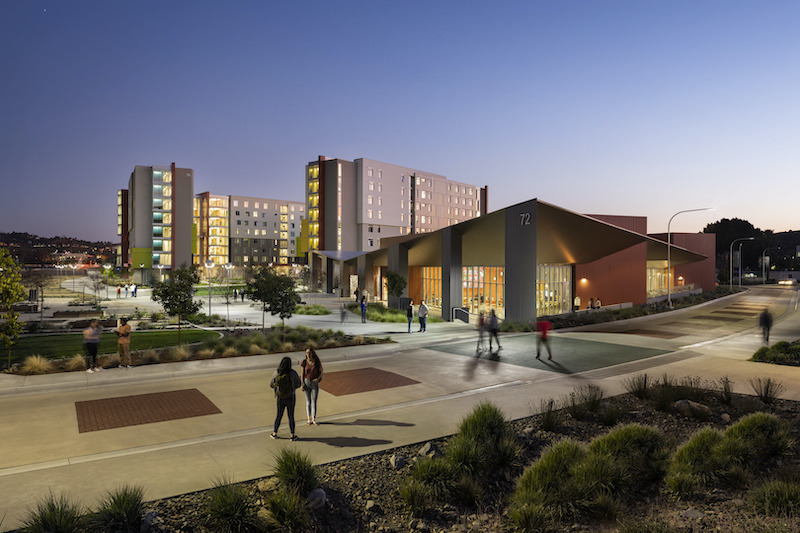In an attempt to eliminate its reputation as a commuter school, California State Polytechnic University, Pomona (Cal Poly Pomona) has recently completed construction of two new eight-story residential towers and a dining commons.
The 340,000-sf project offers first-year student residents smaller communities within larger towers, with each floor providing two 35-student households with places to congregate, socialize, and study. Bedrooms feature natural light and hallways end in views toward the campus and the San Gabriel Mountains. The two buildings interlace shared social spaces, natural light, and open air connections throughout the eight floors.
A diversity of connections between the indoors and the outdoors is a defining feature. Ground-floor amenities are connected to outdoor spaces while balconies on the fifth floor connect students livening on upper floors to the outdoors. Living rooms and lounges use full-height glass to visually connect students outside with what is happening inside.
See Also: Phase one of The Orbit masterplan detailed for Innisfil, Ontario
Meanwhile, the new 650-seat dining commons, located at the campus entrance and gateway to the housing community, features warm materials, residential lighting, and large communal tables. Private eating areas and conference rooms are also included.
The first students moved into the new buildings on January 17, staying for two months before students were all sent home due to COVID-19.
The collaborative design-build team consisted of HMC Architects (executive architect and housing design architect), EYRC Architects (dining commons architect), and Sundt Construction.
Related Stories
| Feb 6, 2012
Siemens gifts Worcester Polytechnic Institute $100,000 for fire protection lab renovation
Siemens support is earmarked for the school’s Fire Protection Engineering Lab, a facility that has been forwarding engineering and other advanced degrees, graduating fire protection engineers since 1979.
| Feb 2, 2012
Fire rated glazing helps historic university preserve its past
When the University embarked on its first major addition since the opening of Hutchins Hall in 1933, preserving the Collegiate Gothic-style architecture was of utmost importance.
| Feb 2, 2012
Next phase of construction begins on Scripps Prebys Cardiovascular Institute
$456 million Institute will be comprehensive heart center for 21st Century.
| Feb 1, 2012
Two new research buildings dedicated at the University of South Carolina
The two buildings add 208,000 square feet of collaborative research space to the campus.
| Jan 31, 2012
Fusion Facilities: 8 reasons to consolidate multiple functions under one roof
‘Fusing’ multiple functions into a single building can make it greater than the sum of its parts. The first in a series on the design and construction of university facilities.
| Jan 27, 2012
BRB Architects designs new campus center for Molloy College
Intended to be the centerpiece of the College’s transformation from a commuter college to a 24-hour learning community, the “Public Square” will support student life with spaces such as a café, lounges, study rooms, student club space, a bookstore and an art gallery.
| Jan 19, 2012
BOKA Powell-designed facility at Texas A&M Bryan campus
The new facility provides programs for the Texas A&M Health Science Center, the Texas Brain and Spine Institute, Mary Crowley Cancer Research Centers, and Blinn College Allied Health programs.
| Jan 4, 2012
Shawmut Design & Construction awarded dorm renovations at Brown University
Construction is scheduled to begin in June 2012, and will be completed by December 2012.
| Jan 3, 2012
New Chicago hospital prepared for pandemic, CBR terror threat
At a cost of $654 million, the 14-story, 830,000-sf medical center, designed by a Perkins+Will team led by design principal Ralph Johnson, FAIA, LEED AP, is distinguished in its ability to handle disasters.
| Dec 20, 2011
Gluckman Mayner Architects releases design for Syracuse law building
The design reflects an organizational clarity and professional sophistication that anticipates the user experience of students, faculty, and visitors alike.
















